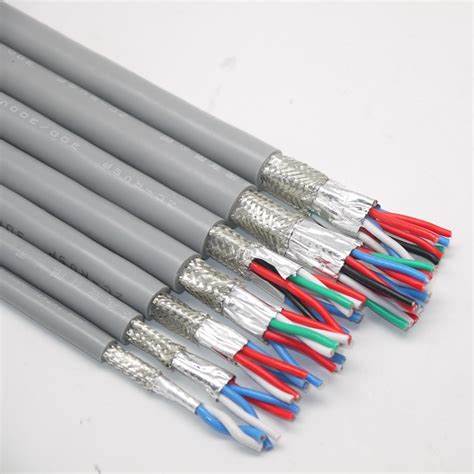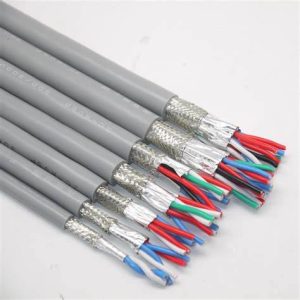

Alət kabelləri, tez-tez idarəetmə kabelləri kimi müraciət etdiyimiz şeydir.
Alət kabeli tez-tez nəzarət kabeli dediyimiz şeydir, ölçmə alətləri kimi digər elektrik avadanlıqlarında siqnal ötürülməsi və idarəetmə xətləri üçün uyğundur.


Stranded conductors can improve the flexibility of the conductor and flexibility, easy wiring installation.
When stranded conductors are used in vibration situations, the service life of the cable can be improved appropriately.
The cross-sectional area of the cable conductor is mainly determined by the permissible temperature rise of the conductor insulation material and the permissible voltage drop on the conductor.
General instrumentation cable signal is a weak signal, do not consider the temperature rise and allowable voltage drop.
Buna görə də, the cross-sectional area of the conductor is mainly determined according to the mechanical strength of the conductor and the requirements of the detection and control circuit for line impedance matching.
Copper has excellent electrical characteristics and durability, and is often chosen as the material for cable conductors.
After cold working, the resistivity of copper conductors increases, hardness and strength increase, and plasticity decreases.
To improve the conductivity and flexibility of cold-drawn copper wire, annealed copper conductors are often used.
The electrical conductivity of copper conductors also decreases with increasing temperature.
The main purpose of the insulation layer is to ensure the insulation between adjacent conductors of the cable, and the choice of material is related to factors such as ambient temperature, fire protection requirements, environmental requirements, and relevant standards.
In chemical installations, the insulation materials of instrument cables are commonly used such as polyvinyl chloride (PVC), polietilen (PE), and cross-linked polyethylene (XLPE).
PVC is widely used in cable insulation materials because it is inexpensive and can be added with a variety of compatibilizers to improve temperature resistance, alov gecikdirici, yağ müqaviməti, acid and alkali corrosion resistance, və digər xassələri.
Ordinary PVC insulated instrument cable conductor long-term allowable operating temperature of 70 ℃, short-circuit thermal stability allowable temperature of 160 ℃. After adding the corresponding heat-resistant plasticizer, the conductor’s long-term allowable operating temperature is up to 90 ℃ and 105 ℃.
At low temperatures, PVC-insulated cables tend to become hard and brittle.
PVC-insulated cables should not be used at temperatures lower than -15 °C.
Due to the halogen content, it produces thick toxic black smoke when burning, which does not satisfy the use of low-smoke, non-toxic occasions, and the insulation layer can be replaced by non-chlorine flame retardant compounds (HFFR).
Compared with PVC, PE has excellent electrical properties, such as low dielectric loss and high dielectric strength.
PE insulation is better than PVC cold resistance, yüngül, and in the same voltage level as the PVC insulation layer thickness is small.
Lakin, PE material is hard, low softening temperature, is easy to burn and melt when in contact with flame, poor resistance to environmental stress.
PE insulated cable heat-resistant grade is mainly divided into 70 ℃ and 80 ℃.
XLPE is a change of PE from thermoplastic to thermosetting, resulting in greater resistance to stress cracking and cutting, as well as greater adaptability to solvent changes.
XLPE has a higher dielectric constant than PE but with better resistance to aging and water.
The long-term permissible operating temperature of the conductor of the insulated instrument cable of XLPE is 90°C, and the permissible short-circuit thermal stabilization temperature is 250°C. The insulation of XLPE for instrument cables has a higher dielectric constant than PE.
The thickness of the insulation layer of the instrument cable is mainly related to the cross-sectional area of the conductor, the voltage resistance level, the insulation material, və s.
The thickness of the insulation layer should not be less than the provisions of the relevant standards for the selected cable.
Insulation also serves as the instrument cable insulation core identification mark, usually using Arabic numerals, and standard colors to distinguish between the different cores of multicore cables or mark the function of the core.
The main role of the sheath is to protect the cable from external temperature, təzyiq, humidity chemical corrosion, və digər effektlər.
The outer sheath is an important indicator characterizing the performance of the cable in terms of fire resistance, yağ müqaviməti, yüksək temperatur müqaviməti, resistance to bending, resistance to insect pests, və s., and serves as an important carrier for the appearance of the cable marking.
When there is an armor layer, the inner sheath is used to prevent the metal of the armor layer from extruding and damaging the cable.
It can also play a role in improving the performance of the cable fire, yağ müqaviməti, və digər xassələri.
Sheath material selection and environmental temperature, environmental corrosion environmental requirements, and other factors.
Sheath materials commonly used in chemical installations include PVC and HFFR.
The cable marking on the outer sheath is mainly embossed and printed with ink.
Embossing is suitable for cables with large outer diameters, and the embossing process is cumbersome and easy to cause damage to the outer sheath of instrument cables.
Instrumentation cable sheath is generally printed with ink, which can achieve a clear logo, font wear-resistant, and in line with the relevant standard requirements.
Cable sheath color selection is also related to the type of cable.
The armor layer is mainly to enhance the mechanical properties of the cable such as tensile and compressive strength to improve the service life of the cable.
Eyni vaxtda, the armor layer can also be grounded to improve the cable anti-interference performance.
The type of armor has a variety of forms, instrumentation cables commonly used in the form of armor steel wire armor (SWA), steel wire braided armor (SWB), and steel tape armor (STA) three.
To ensure the performance of armored cables, instrumentation cable standards on the diameter of the steel wire, the number of layers of steel tape, thickness, and width, və s. have detailed provisions.
Due to the structure of the armor layer of steel wire or steel tape, the bending radius of the armored cable is larger than that of the non-armored cable.
To avoid causing damage to the cable, when fixing and laying the cable, special attention needs to be paid to the cable manufacturer’s requirements for the bending radius of the cable.
Instrumentation cables and power cables are both commonly used cables in real life, but different product characteristics have different uses.
Instrumentation cables are suitable for AC-rated voltage below 500V, long-term working temperature not exceeding 70℃, and laying temperature not below 0℃.
Power cables include a variety of insulated power cables used for the transmission and distribution of electrical energy, applicable to 1-500KV and above various voltage levels.
Used in the city’s underground power grid, elektrik stansiyaları, industrial and mining enterprises, daxili enerji təchizatı, and underwater transmission lines across the river and the sea.
High-voltage power cables are mainly used for the transmission and distribution of high-power power cable products.
Instrumentation cable does not have a very clear voltage level, generally low voltage, core conductor fine, part of the shielding performance.
Power cables are divided into high-voltage cables, orta gərginlikli kabellər, and low-voltage cables, wire diameter is generally thicker, and they use a relatively wide range.
In chemical installations, instrumentation cables in the selection and design, often consider the following aspects:
According to the requirements of the project contract and patent traders, və s., reasonably select the international standards, national standards, and industry standards to be followed for cable manufacturing, yoxlama, and acceptance, which shall not conflict with the relevant national, industry and local standards while meeting the project design requirements.
Including ambient temperature, environmental corrosion, electromagnetic interference, explosion-proof grade and laying methods, və s., the cable core material, qabıq, shielding, zirehli, laying radius, və s. will have an impact.
Based on the above requirements, according to the design standards and the use of the environment, a reasonable choice of specific parameters for the cable.
Define the manufacturing requirements of the cable, yoxlama, and testing requirements at the factory stage.
The above is a detailed introduction to the instrumentation cable, if you still have questions about the cable purchase selection, welcome to consult the ZMS cable team.
İnsanlar mineral izolyasiya edilmiş kabel termini eşitdikdə, many immediately think of harsh environments like…
Telekommunikasiya şəbəkələri və enerji ötürücü sistemləri sürətlə böyüyür, the demand for reliable and cost-effective…
Güclü neft və qaz layihələrində, Sənaye kabelləri yalnız aksesuar deyil—they are the "nervous…
Elektrik bağlantıları dünyasında, kabel qapaqları—Kabel qulaqları və ya kabel terminalları kimi də tanınır—var…
Elektrik mühəndisliyi layihəsi üçün düzgün rezin kabel seçərkən, it is critical to…
Əziz tərəfdaşlar və müştərilər: 29 yanvar, 2025 Çin Aysal Yeni ilidir – Spring…